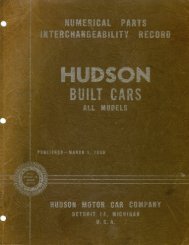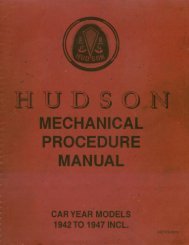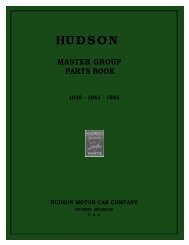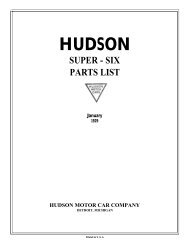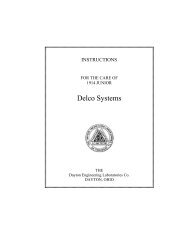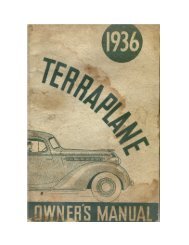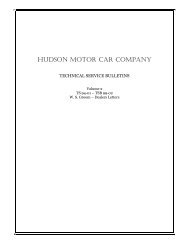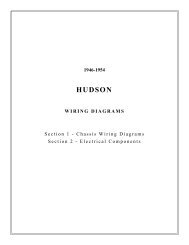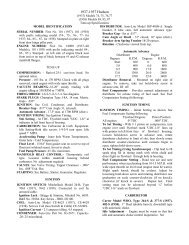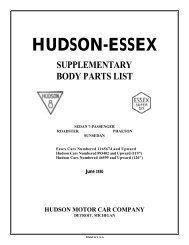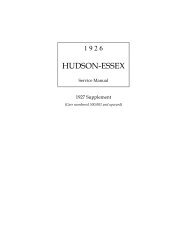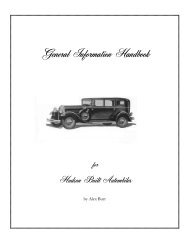1948-1952 Shop Service Manual - - Hudson-Essex-Terraplane Club
1948-1952 Shop Service Manual - - Hudson-Essex-Terraplane Club
1948-1952 Shop Service Manual - - Hudson-Essex-Terraplane Club
Create successful ePaper yourself
Turn your PDF publications into a flip-book with our unique Google optimized e-Paper software.
ENGINE 3 - 5<br />
LUBRICATION<br />
8 CYLINDER<br />
Engine lubrication is by the Duo-flow system which<br />
delivers the lubrication oil in ratio to engine speed to all<br />
bearing surfaces immediately from the first turn of the<br />
crankshaft.<br />
The oil is drawn through a pipe connecting with a<br />
floating screen in the oil pump by the oscillating plunger<br />
type oil pump which is driven from the camshaft.<br />
Oil is forced through oil lines to the front and rear of the<br />
engine where it is then deposited in the splash troughs of the<br />
oil pan tray.<br />
The oil is then picked up by the connecting rod dippers<br />
and vigorously distributed to interior working surfaces by<br />
the splash system and a series of channels which convey it<br />
to wells over the crankshaft and camshaft bearings.<br />
Overflow oil running down the Crankcase wall is diverted<br />
by drain troughs in the oil pan tray until it reaches the center<br />
splash troughs.<br />
LUBRICATION<br />
6 CYLINDER<br />
Full pressure lubrication to friction surfaces of the<br />
engine is maintained by a rotor type centrifugal pump<br />
mounted on the right side of the cylinder block. The<br />
pump is driven by a worm gear on the camshaft. Oil is<br />
drawn through the suction side of the pump by means of<br />
a pipe connecting to a floating screen in the oil pan. The<br />
oil is then forced up into the horizontal oil gallery for<br />
distribution to the valve tappets, camshaft bearings, main<br />
bearings, connecting rod bearings, pistons, piston pins<br />
and bushings, timing chain and sprockets and all other<br />
movable parts requiring lubrication, Figure 8.<br />
NOTE: Normal oil pressure is 40 lbs. at 30 MPH.<br />
OIL CHECK VALVE<br />
8 CYLINDER<br />
The check valve assembly shown in Figure 2 is used in<br />
conjunction with the oscillating plunger type oil pump.<br />
The function of the check valve is to indicate oil flow by<br />
building up enough pressure to operate the oil pressure<br />
indicator light on the instrument panel. This operating pressure<br />
ranges from 4 to 12 pounds.<br />
FIGURE 2<br />
1. Valve body<br />
2. Valve body plug<br />
3. Valve body plug gasket<br />
4. Valve ball<br />
5. Valve plunger<br />
6. Valve plunger spring<br />
7. Valve plunger pin<br />
8. Valve plunger pin retainer<br />
9. Valve pressure indicator pin<br />
10. Pressure indicator pin gasket<br />
11. Pressure pin terminal nut<br />
12. Pressure pin contact nut<br />
13. Pump to check valve pipe elbow<br />
The unit consists of a housing in which is carried the<br />
check ball (4) and a plunger (5) which operates against the<br />
pressure of a spring (6).<br />
When there is no oil flowing and therefore no pressure,<br />
the plunger is pushed down by the spring and contacts an<br />
insulated pin (9) which is the ground for the signal light.<br />
The light will burn until sufficient oil pressure is developed<br />
to raise the plunger.<br />
A bleed path is provided between the plunger and pin<br />
(7) to allow a small quantity of oil to pass by the piston to<br />
the outlet. This hole must be kept clean or the lamp will not<br />
light immediately when the oil flow stops because the



